Abstract
Field research on the performance of pollutant removal and the structure of the microbial community was carried out on a drinking water reservoir. After one month of operation of a water-lifting aeration system, the water temperature difference between the bottom and the surface decreased from 9.9 to 3.1 °C, and the concentration of the dissolved oxygen (DO) in the bottom layer increased from 0 to 4.2 mg/L. The existing stratification in the reservoir was successfully eliminated. Total nitrogen (TN), total phosphorus (TP), and total organic carbon (TOC) concentrations were reduced by 47.8%, 66.7%, and 22.9%, respectively. High-throughput sequencing showed that Proteobacteria, Bacteroides, and Actinomycetes accounted for 67.52% to 78.74% of the total bacterial population. Differences in the bacterial changes were observed between the enhanced area and the control area. With the operation of the water-lifting aeration system, the populations of bacteria of the main genera varied temporally and spatially. Principal component analysis pointed out a clear evolution in the vertical distribution of the microbial structure controlled by the operation of the aeration system. Permutational analysis of variance showed a significant difference in the microbial community (p < 0.01). Redundancy analysis showed that physical (water temperature, DO) and chemical environmental factors (Chl-a, TOC, TN) were the key factors affecting the changes in the microbial communities in the reservoir water. In addition, a hierarchical partitioning analysis indicated that T, Chl-a, ORP, TOC, pH, and DO accounted for 24.1%, 8.7%, 6.7%, 6.2%, 5.8%, and 5.1% of such changes, respectively. These results are consistent with the ABT (aggregated boosted tree) analysis for the variations in the functional bacterial community, and provide a theoretical basis for the development and application of biotechnology.
1. Introduction
In recent years, the water quality in reservoirs and lakes providing drinking water to cities has become an increasingly prominent issue. Algal outbreaks [1], runoff intrusion [2], release of sediments [3], and other types of input pollution [4] have been widely reported. Artificial lakes used as reservoirs usually experience shorter retention times and more intense water level fluctuations than natural lakes. Therefore, different physical, chemical, and biological processes can occur in these aquatic systems [5]. For instance, in subtropical areas, during the late autumn and early winter, reservoirs and lakes experience a natural mixing process. During this mixing, water containing pollutants released from the sediment under long-term anaerobic conditions is incorporated into the whole water column. This causes water pollution in the entire water body. In our research, we studied a pollution issue in Jinpen Reservoir. In this reservoir, a nitrogen concentration of nearly 1.7 mg/L was measured, which is a value exceeding the Chinese standards. Total phosphorus and iron, which exceeded the standards seasonally, also were sometimes a problem for the reservoir.
In order to address pollution in reservoirs, researchers have provided many methods for water quality improvement. For instance, enhanced coagulation to remove dissolved organic carbon was studied, yet it was found useful only for removing large or hydrophobic organic molecules, but not for small or hydrophilic molecules [6]. A reasonable control of water residence time can slow the rate of total nitrogen (TN) increase in water bodies acting as N sinks, but can accelerate its removal from water bodies acting as N sources [7,8]. The use of calcium silicate hydrate to remove phosphorus in water was attempted, yet safety issues arose [9]. Aerobic denitrifying bacteria were found to play a role in water quality improvement in reservoirs, especially for N removal [10]. In summary, physical, chemical, and biological technologies have been used for pollutant removal. However, neither physical nor chemical methods have been able to remove the pollutants completely, despite being high-cost methods [11]. On the other hand, bioremediation—a biological technology entailing the use of microorganisms—has the advantage of not producing secondary pollution or residues while eliminating or reducing the concentrations of hazardous wastes in contaminated sites.
Microbial communities play a key role in the decomposition of organic matter and the recycling of nutrients in freshwater ecosystems [12]. Differences in the diversity level of microbial composition and community structures among oil reservoirs were evaluated by environmental variation, and the results were useful for the application of indigenous microbial communities [13]. The effects of wet and dry seasons on the bacterial community structure of the Three Gorges Reservoir were researched by Chen [14] using denaturing gradient gel electrophoresis analysis of the PCR-amplified bacterial 16S rRNA gene, and the dominant population was identified. The microbial community has also been analyzed in membrane treatment. It was found that the addition of poly aluminum chloride can improve the performance of the membrane bioreactor by developing different bacterial species and controlling the assailable organic carbon and the associated biofouling on the membranes [15]. Indigenous microbial community variation was observed, which helped to develop and apply more microbial-enhanced oil recovery processes [16]. Indigenous microorganisms in porous concrete may play an important role in pollutant removal from surface water, and Proteobacteria were found to dominate in bacterial communities in both planted and unplanted porous concrete systems [17]. In Lake Bourget, the seasonal succession of the main bacterial was observed, and their impact on bacterial structure and dynamics was determined to be likely relevant in similar ecosystems [18]. Microbial diversity and richness in a wastewater treatment plant were found to be negatively associated with elevation, and positively associated with the water temperature to a certain extent [19]. Bacterial abundance was positively correlated with the total phosphorus (TP) concentration in the Qingcaosha Reservoir [20]. Furthermore, significant spatial and temporal changes were observed in the microbial community composition of an estuarine reservoir [21]. The above reports suggest that the microbial community is a key factor in improving water quality. The evolution of microbial population structure can help us better understand the mechanism of water purification.
With regard to in situ water quality purification, mixing and aeration technologies have also been used, and satisfactory results have been achieved [22]. A water-lifting aeration system was installed in the drinking water reservoir which we were investigating, giving us the opportunity to explore the variation in microbial population structure in situ. In a previous study, a satisfactory improvement in water quality was achieved [23]. In this study, we carried out field research in a canyon-shaped drinking water reservoir, the Jinpen Reservoir.
Our research was motivated by the following research questions: (1) At field scale, what is the performance of a water lifting aeration system in terms water quality improvement? (2) How does the microbial community structure vary between the natural state and that resulting from artificial mixing? (3) Which environmental factors can affect the change of microbial communities, and what is the relative influence of the environmental factors?
This study was designed to specifically address these questions. The variation in the microbial community structures in two areas was studied through high-throughput sequencing. Furthermore, principal component analysis (PCA), permutational analysis of variance (PERMANOVA), redundancy analysis (RDA), and ABT were utilized to identify the main factors influencing the microbial community structure evolution.
2. Materials and Methods
2.1. Sampling Sites and Field Work
The Jinpen reservoir (34° 13′ N to 34° 42′ N, 107° 43′ E to 108° 24′ E) is the source of drinking water for the city of Xi’an in Shaanxi Province. It is a large reservoir with a capacity of 2.0 × 108 m3, and a mean depth of about 80 m. In the reservoir, 8 water lifting aerators are installed at various locations [23] in order to improve water quality. Two sampling sites, which we termed here “enhanced area” (E) and “control area” (C) were selected, the locations of which are shown in Figure 1. “E” was located in the middle of the artificial mixing area. “C” was located far away (2 km) from the artificial mixing area. Hence, site E and site C were the representatives of the experimental area and comparison area, respectively. In each sampling site, a surface water (0.5 m depth) sample, middle water (40 m depth) sample and bottom water (80 m depth) sample were collected. Each water sample had three parallel samples. When the water temperature difference between surface water and bottom water was less than 1 °C, it was considered that the water was completely mixed.
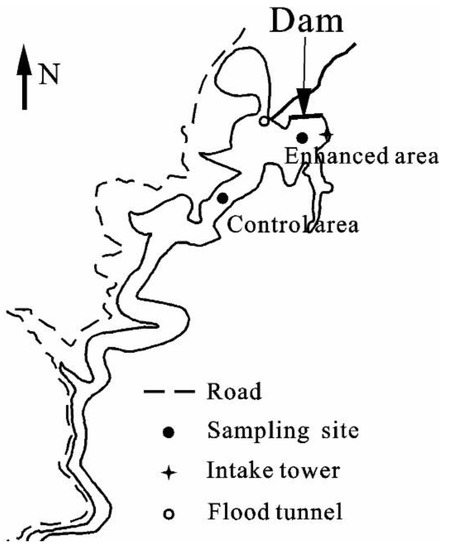
Figure 1.
Sampling sites in the enhanced area and control area of Jinpen reservoir.
During the operation of the water-lifting aeration system, water samples were collected every 3 days. Water temperature, dissolved oxygen (DO), oxidation-reduction potential (ORP), turbidity, Chl-a (chlorophyll-a), and pH were examined every 3–5 m in situ by a Hach DS5 multifunctional water quality parameter analyzer. Water quality indices, such as total nitrogen (TN), total phosphorus (TP), and total organic carbon (TOC) were examined in the laboratory, and water samples were collected in triplicate every 10 m. Water samples from the enhanced and control areas were stored in pre-cleaned high-density polyethylene bottles. The samples were immediately cooled and stored at 4 °C until analysis took place.
The objective of mixing aeration was achieved through the operation of a water-lifting aeration system. The operating conditions of the water-lifting aeration system were as follows: Eight water-lifting aerators were running at full load, and each gas supply volume was approximately 50 m3/h, 24 h per day, from 28 September 2018 to 29 October 2018.
2.2. Physical and Chemical Analysis
Temperature, DO, pH, Chl-a, turbidity, and ORP were determined in situ every 3–5 meters using a Hach multi-probe water quality analyzer (Hydrolab DS5, Loveland, CO, USA). The concentrations of TN, nitrate, ammonia, and nitrite were determined using a SEAL AA3 HR AutoAnalyzer (SEAL, Hamburg, Germany). TOC concentrations were measured with a TOC-L TOC analyzer (Shimadzu, Kyoto, Japan) [24].
2.3. High-Throughput Sequencing
A 1-liter water sample was collected, and the water sample was filtered by a 0.22 μm acetate fiber membrane using a vacuum filter pump. The filtered membrane was stored at −22 ℃. DNA extraction and Illumina MiSeq high-throughput sequencing were carried out by Meiji biology Co., Ltd. (Shanghai, China). High-throughput sequencing was mainly used to study the composition of the microbial communities. Using primers 27F (5’-AGAGTTTGATCCTGGCTCAG-3’) and 338R (5’-TGCTGCCTCCCGTAGGAGT-3’) to amplify the V2 region of bacteria in the 16S rRNA gene by PCR [25], PCR amplification was carried out in triplicate using ABI GeneAmp® 9700 PCR System (Saibaiao, Beijing, China) in a total volume of 20 μL PCR reaction mix. All PCR products were separated by 2% gel electrophoresis. The amplicons with sequences shorter than 200 bps and of low quality (quality score < 25) were removed. High-quality sequences were clustered into operational taxonomical units (OTU) at a 97% similarity level and singleton OTUs were eliminated. Meanwhile, the taxonomic classification of effective sequences was determined using the RDP (Ribosomal Database Project) database: http://rdp.cme.msu.edu/. For fair comparison, the size of each sample was normalized to the same sequencing depth by randomly removing the redundant reads. Alpha diversity, beta diversity, and microbial community composition were analyzed based on the OUT results [26]. Based on the OTU clustering analysis results, OTU diversity indices and the depth of sequencing were researched. Based on the taxonomic information, a statistical analysis of the community structure was carried out at each taxonomic level [27]. On the basis of the above analysis, a series of statistical and visual analyses of community structure and phylogeny can be carried out [28].
2.4. Data Analysis
The statistical and visual analysis was showed as follows: We tested for mixing and stratification of water effects on community dissimilarity with permutational analysis of variance (PERMANOVA) using the functions adonis in the vegan package with 104 permutations [29]. For each environmental variable, we performed hierarchical partitioning based on Hellinger-transformed rarefied OTU matrix using the rdaenvpart R package [29] and ABT (aggregated boosted tree) analysis [30] to examine the correlation between environmental variables and microbial community composition.
3. Results and Discussion
3.1. Effects of Mixing Aeration on Water Quality
The operation of the water-lifting aeration system lasted for about one month from 28 September to 29 October 2018. During this period, the stratification of the reservoir was almost completely destroyed. On 28 September (the first day of operation), the surface water temperature and the bottom water temperature in the enhanced area were 19.8 and 9.9 °C, respectively, for a temperature difference of 9.9 °C, as shown in Figure S1. At the end of the operation (29 October), the water temperature difference had decreased to 3.1 °C. At this time, the average air daily temperature had dropped to 10 °C, and the water temperature had started to decrease rapidly along with the air temperature. The water-lifting aeration system was able to achieve a link between artificial forced mixing and natural mixing. Compared with the enhanced area, the control area was still in a stratification state, and the temperature difference between the bottom water and surface water was 8 °C.
At the same time, variation in DO in the water column was also significant; this indicates that the aeration rate of the water-lifting aeration system was high. As shown in Figure S2, on 28 September, the thickness of the anaerobic zone (DO of 0 mg/L) was almost 9 m; this indicates that the bottom water body had been in a severe anaerobic state for a long time. On 29 October, the DO concentration of the bottom water was 4.2 mg/L, achieving an aerobic condition. With the operation of the water-lifting aeration system, there was an area of significant increase in DO about 6 m above the bottom water, which was due to oxygenation by isothermal layer aeration. In the control area, the DO concentration was still 0 mg/L in the bottom water.
The reduction in TN and TP by the operation of the water-lifting aeration system was mainly due to two mechanisms: First, the release of ammonia nitrogen and phosphorus from sediments was inhibited by increasing DO in the bottom water; second, the continuous mixing effect improved the temperature and DO concentrations in the middle and lower water layers in the reservoir, enhancing the activity of aerobic denitrifying microorganisms in the water, and improving the mixing oxidation conditions of the reservoir, which promoted the oxidation and precipitation of phosphorus in the water. As shown in Figure 2, after operating the water-lifting aeration system, the TN and TP concentrations both obviously decreased. The average concentration of TN decreased from 1.82 mg/L at the start of operation to 0.95 mg/L at the end of operation, which was a reduction of 47.8%. The average concentration of TP decreased from 0.036 to 0.012 mg/L, which was a reduction of 66.7%. In comparison, the TN and TP in the control area decreased by only 14.7% and 18.8%, respectively. Nitrogen removal attracted more and more researchers’ attention. From the perspective of reservoir management, water level control can also help to remove nitrogen [31]. Recently, a novel aerobic denitrifying fungus was reported as having high nitrogen and organic matter removal [32], all of these likely enriched the mechanism of nitrogen removal.
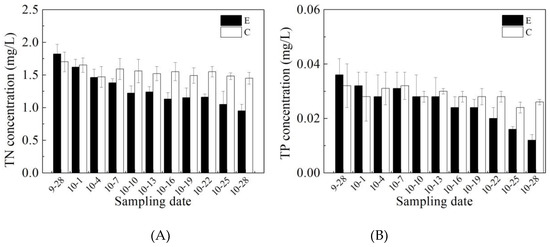
Figure 2.
Changes in total nitrogen (TN) (A) and total phosphorus (TP) (B) concentrations (mean values) in the enhanced area and in the control area during the period of operation of the water-lifting aeration system. In the legends, C stands for “control area” and E for “enhanced area”.
As shown in Figure 3, TOC concentrations in the enhanced area and control area present the same trend as the TN concentrations. The TOC of the enhanced area decreased from 3.5 to 2.7 mg/L, which was a reduction of 22.9%. In the control area, the TOC decreased by only 12.5%. The same trend was observed in our previous study. As the results showed in other drinking reservoirs, bacterial production played a very important role in dissolved organic matter degradation: dissolved organic matter degradation was high enough to decrease the loads to reservoirs considerably [33].
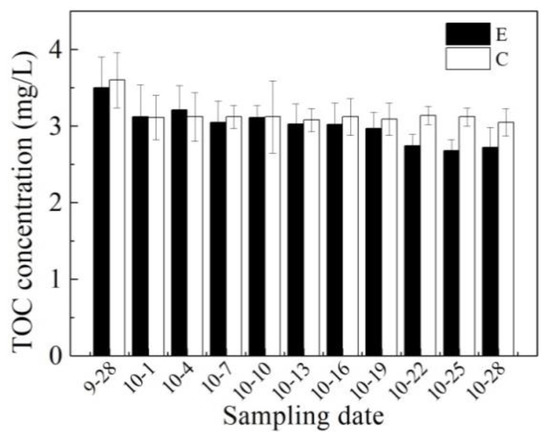
Figure 3.
Changes in total organic carbon (TOC) concentration (mean values) in the enhanced area and control area during the running period of the water-lifting aeration system. In the legend, C stands for “control area” and E for “enhanced area”.
Based on these results, the stratification in Jinpen Reservoir was nearly destroyed by the running of the water-lifting aeration system; the bottom water layer was oxidized, and DO concentration increased to 4.2 from 0 mg/L. TN, TP, and TOC contents in the water column of the enhanced area were significantly reduced. The running of the water-lifting aeration system not only provided oxygen to the reservoir, but also assisted in improving the water quality. There is no doubt that changes in the water structure and water quality would inevitably affect changes in the water microorganisms [34]. DO and nitrogen were likely the major factors that influenced the microbial communities found in the raw water [35]. Thus, based on these water quality analyses, the microbial community structures in both the enhanced and control areas were explored.
3.2. Effects of Mixing Aeration on Microbial Community Structure
Changes in microbial community structure in the enhanced and control areas were explored by using the high-throughput sequencing. As shown in Table 1, a total of 701,702 valid sequences and 14,091 OTUs (97% similarity) were obtained by sequencing. The AEC index varied mainly between 617 and 1205, and the Chao diversity index varied between 616 and 1122. The average coverage of the enhanced area and the control area reached 0.9938 and 0.9940, respectively, indicating that the sequencing results reflect the microbial community structure well [36]. The microbial community diversity and richness in the enhanced area were highly improved over those of the control area by the mixing aeration, especially in the surface water. For example, on 15 October the Chao1 of the surface water was 1004 in the enhance area, and that in the control area was 641. The shannon index of the surface water in the enhanced area on 15 October was 4.32 and that in the control area was 4.04. After running the water-lifting aeration system, the whole reservoir trended to mixing; on 28 November, the values of microbial diversity and richness tended to be consistent. The mixing aeration helped to increase the microbial diversity index. Compared with the Three Gorge Reservoir, less OTUs were obtained in Jinpen Reservoir in the control area [37]. Both results showed that local water quality played an important role in the distribution of bacterial community.

Table 1.
Spatial and temporal distribution of the microbial community diversity and richness estimators in the enhanced and control areas.
Microbials belonging to seven main categories were found during the operation of the water-lifting aeration system: Proteobacteria, Bacteroidetes, Actinobacteria, Cyanobacteria, Firmicutes, Chloroflexi, and Verrucomicrobia (Figure 4 and Figure 5, Figures S3 and S4). Among them, Proteobacteria, Bacteroides, and Actinomycetes accounted for 67.52%–78.74% of the total bacterial population.
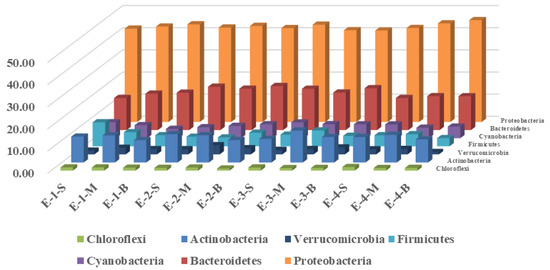
Figure 4.
Distribution of main phyla in enhanced areas during the operation of water lifting aerators (The vertical axis represents the percentage of different bacteria; X-Y-Z, area-period-location; X = C and E are control and enhanced areas; Y = 1, 2, 3, 4 refer to 2018-09-28, 2018-10-15, 2018-10-29, 2018-11-28; Z = S, M, B, are surface, medium, and bottom water layer).
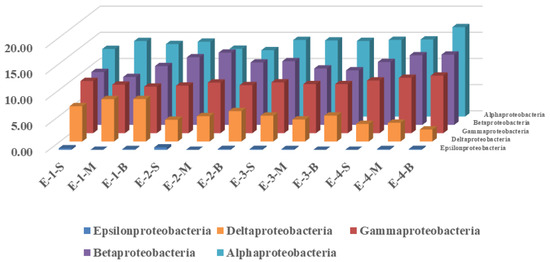
Figure 5.
Changes in the proportions of Proteobacteria in the enhanced area during the operation of the water-lift aeration system. Labeling is consistent with that of Figure 4.
During the operation of the water-lifting aeration system, the proportion of Proteobacteria in the control area decreased from (44.76 ± 1.75)% to (42.93 ± 1.34)%, whereas in the enhanced area it increased from (43.09 ± 0.96)% to (44.28 ± 1.78)%. The proportion of Bacteroidetes, which are well-known degraders of organic matter, decreased from (18.26 ± 0.95)% to (14.45 ± 1.34)% in the control area, while in the enhanced area it decreased from (15.92 ± 1.28)% to (15.02 ± 0.46)%. The variation in Bacteroidetes shows that the TOC in the enhanced area degraded faster than that in the control area. Furthermore, the proportion of Actinomycetes, which play a crucial ecological role in the recycling of refractory biomaterials and DOM [38], increased in the enhanced area from (11.65 ± 1.75)% to (12.25 ± 0.78)%, while it changed little in the control area. As for Cyanobacteria, they were a key group responsible for environmental problems associated with eutrophication processes [39]. In Jinpen Reservoir, Cyanobacteria was also a very important monitoring indictor. Research showed that TP and water clarity were identified as the most influential environmental factors correlated with phytoplankton community composition [40]. In our next research, more water quality parameters will be taken into consideration for further analysis on microbials.
Alphaproteobacteria, a class of Proteobacteria, have been reported to contribute to DOC removal [41]. During the process of mixing aeration, the Alphaproteobacteria in the control and enhanced areas showed first a decreasing, and then an increasing trend. In the control area, Alphaproteobacteria decreased from (15.27 ± 1.07)% to (14.40 ± 0.73)%, and finally increased to (16.12 ± 0.94)%. That of the enhanced area decreased from (13.74 ± 0.96)% to (13.32 ± 0.87)%, and finally increased to (15.50 ± 1.39)%. The Betaproteobacteria in the control system showed a decrease, from (12.30 ± 0.86)% to (11.65 ± 0.06)%. There was an obvious increase in the enhanced area, from (10.17 ± 1.04)% to (12.92 ± 0.76)%. The Gammaproteobacteria in the control area decreased first and then increased, from (9.02 ± 0.80)% to (8.08 ± 0.78)% in the beginning, and finally increased to (9.32 ± 0.92)% at the end. There was an obvious increase in the enhanced area, from (9.38 ± 0.55)% at the beginning to (10.55 ± 0.46)%. The Deltaproteobacteria in both the control and enhanced area showed a decrease: that in the control area decreased from (6.39 ± 0.68)% to (3.82 ± 0.38)%, and in the enhanced area decreased from (7.65 ± 0.79)% to (3.07 ± 0.69)%. The changes in Epsilonproteobacteria in the control and enhanced areas were not significant. This showed that the operation of the aeration system had a greater effect on the enhanced area. Considering the microbial abundance increasing in the enhanced area, as reported in our another research [42], a conclusion might be drawn that aeration and mixing helped improve microbial activity and metabolism of pollutants.
During the process of aeration, as shown in Figure 6, the phylum Flavobacterioides in the control area decreased from (7.40 ± 1.16)% to (6.03 ± 0.54)%, and in the enhanced area increased from (5.91 ± 0.26)% to (7.10 ± 0.38)%, and finally to (6.26 ± 0.03)%. The Sphingomycetes in the control area decreased from (8.11 ± 0.95)% to (5.70 ± 0.39)%, and in the enhanced area increased from (7.00 ± 1.10)% to (8.12 ± 0.18)%, and finally decreased to (6.49 ± 0.44)%. The microbial community structure in the control and enhanced areas showed different change processes, which shows that the microbial community structure in the water body could be changed by the operation of the water-lifting aeration system. Proteobacteria played a very important role in DOC and N cycles, so more attention should be paid to Proteobacteria. Considering that bacterial diversity differed depending on the drinking water distribution, Proteobacteria could be taken out of the original reservoir and an experiment on its decontamination characteristics should be carried out in the next research.
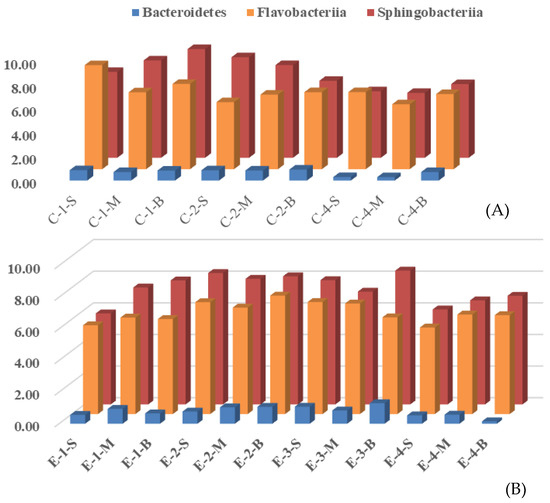
Figure 6.
Changes in Bacteroides in the reservoir during the operation of the water-lifting aeration system: (A) change in the control area; (B) change in the enhanced area. Labeling is consistent with that of Figure 4.
The changes in the bacteria of the main genera in the water column of the control area and the enhanced area during the operation of the water-lifting aeration system (for proportions of genera >1%) are shown in Figure 7. In the control area, Cyanobacteria increased from 6.94% (2018-09-28) to 9.03% (2015-10-28), then decreased to a final value of 4.09% (2018-11-28); Parcubacteria_norank increased from 0.65% (2018-09-28) to 1.72% (2018-10-28), then to 5.69% (2018-11-28); hgcI_clade decreased from 3.69% (2018-09-28) to 2.48% (2018-09-28). Flavobacterium decreased from 2.82% (2018-09-28) to 0.86% (2018-10-28), and then increased to 2.19% (2018-11-28); Fluviicola showed a downward trend, from 3.25% (2018-09-28) to 2.58% (2018-10-28), and then decreased to a final value of 1.90% (2018-11-28); Nocardioides decreased from 0.43% (2018-09-28) to 0.22% (2018-10-28), and then decreased to 1.17% (2018-11-28); TM6_norank rose from 0.00% (2018-09-28) to 1.17% (2018-11-28).
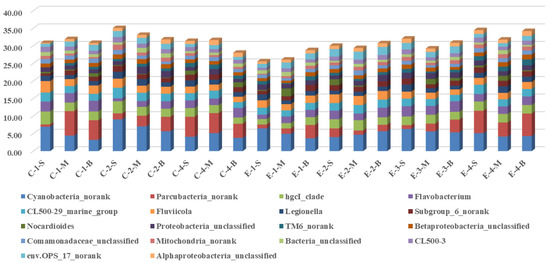
Figure 7.
Distribution of the main genera during the operation of the water-lifting aeration system (>1%). Labeling is consistent with that of Figure 4.
In the enhanced area of the lifting aeration system, Cyanobacteria decreased from 6.46% (2018-09-28) to 4.00% (2018-10-15), and then to 5.12% (2018-11-28), and Parcubacteria_norank increased from 1.12% (2018-09-28) to 2.46% (2018-10-15), and then to 1.08% (2018-10-28) and finally to 6.36% (2018-11-28) at the end of the operation of the lifting aeration system. HgcI_clade increased from 1.54% (2018-09-28) to 2.47% (2018-10-28), and finally to 2.65% (2018-11-28); Flavobacterium increased from 1.26% (2018-09-28) to 2.46% (2018-10-15), and then to 2.93% (2018-10-28) at the end of the operation of the water-lift aeration system, and finally to 2.12% (2018-11-28); Fluicola remained basically unchanged from 1.94% to 2.46%; Subgroup_6_norank increased from 0.98% (2018-09-28) to 1.54% (2018-10-15), Mitochondria_norank increased from 0.28% (2018-09-28) to 0.77% (2018-10-15), then to 1.08% (2018-10-28) and finally to 1.06% (2018-11-28). The variation of Cyanobacteria showed that water lifting aeration had the function of controlling algae propagation. A new research indicated that temperature control should be considered as a component of water management practices in controlling algae [43].
In conclusion, there were differences in the bacterial changes between the enhanced area and the control area, and with the operation of the water-lift aeration system, the main genera of bacteria varied greatly in time and space.
3.3. PCA of Microbial Community
PCA was used to explore the temporal and spatial changes in microbial communities with the operation of the water-lifting aeration system. PCA based on the phylum, class, and genus classification level is shown in Figure 8A–C.
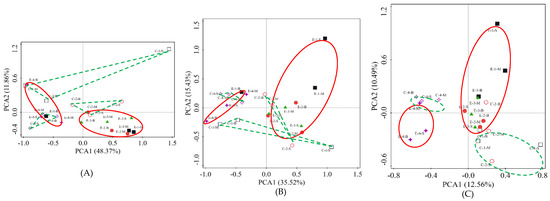
Figure 8.
Principal component analysis (PCA) of water samples in the enhanced and control areas: (A) at phylum level; (B) at class level; (C) at genus level.
At the phylum classification level (Figure 8A), PC1 and PC2 account for 60.24% of the total; the cumulative contributions of PC1 and PC2 are 48.37% and 11.86%, respectively. The vertical distribution of microorganisms in different regions was different at the beginning of the experiment. As the experiment progressed, the microbial structure of the enhanced area obviously evolved, and the difference between the two areas remained. The vertical differences within the enhanced area during operation were smaller than those in the control area, which was consistent with the artificial mixing effect of the operation of the water-lifting aeration system.
At the class level (Figure 8B), PC1 and PC2 account for 50.95% of the total; the cumulative contributions of PC1 and PC2 are 35.52% and 15.43%, respectively. The microbial community structure in the enhanced area and the control area showed obvious spatial and temporal differences. The sample distribution at the same time was more aggregated; and the samples in different areas were obviously separated.
At the taxonomic level of genera (Figure 8C), PC1 and PC2 account for 23.05%; the cumulative contributions of PC1 and PC2 are 12.56% and 10.49% respectively. The vertical differences in microbial community structure in the enhanced area decreased gradually with the operation of the water-lift aeration system; the samples in different areas and periods were distributed in different locations on the PCA map, and the microbial community in the control and enhanced areas were distributed in different locations. The structure of the microbial community in the two areas became similar one month after the end of the aeration operation. Meanwhile, the water community composition presented significantly difference between enhanced area and control area (F = 2.82, p = 0.002 < 0.01) based on PERMANOVA analysis (999 permutations).
Unlike in the Zhoucun Reservoir experiment, the Jinpen Reservoir was a canyon-shaped deep-water reservoir. The operation of the water-lifting aeration system had a weak influence at the periphery. The microbial community structure of the two areas showed obvious differences in the classification levels of the phylum, class, and genera.
3.4. Analysis of the Relationship between Environmental Factors and Microbial Communities
As mentioned above, the different microbial communities in the water samples from the enhanced and control areas were discriminated at the phylogenetic and genetic levels. In detail, as shown in Figure 9A, the RDA (redundancy analysis) analysis showed that the first two RDA dimensions (8 parameters, VIF < 20, F = 1.4, p = 0.002) could explain 20.13% of microbial community changes, with the contributions of RDA1 and RDA2 being 11.94% and 8.19%, respectively. Physical (temperature, DO) and chemical environmental factors (CHl-a, TOC, TN) are the key factors affecting the changes in the microbial community in the reservoir water.
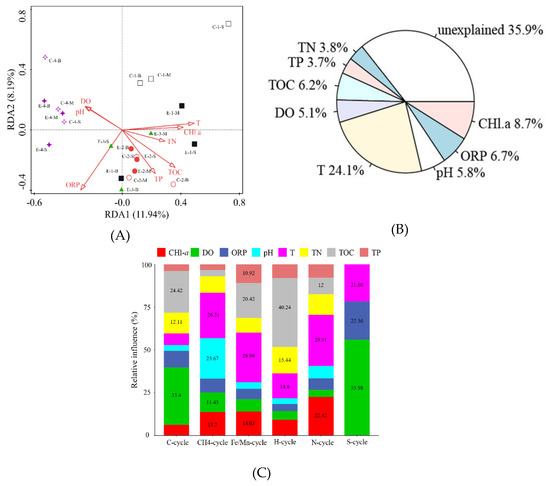
Figure 9.
Relationship between environmental factors and microbial communities in Jinpen Reservoir: (A) redundancy analysis (RDA); (B) hierarchical partitioning analysis; (C) aggregated boosted tree (ABT) for functional bacteria.
As for Figure 9B, based on hierarchical partitioning analysis through rdaenvpart in R, T was found to be the main controlling factor for the variation of bacterial community during the operation of the water-lifting aeration system, which accounted for 24.1% of the variation. The Chl-a, ORP, TOC, pH, and DO accounted for 8.7%, 6.7%, 6.2%, 5.8%, and 5.1% of the variation, respectively.
An aggregated boosted tree (ABT) analysis was carried out using R.2.9.1 (gbmplus package) to quantitatively evaluate the relative influence of the water physicochemical factors on bacterial community diversity. For the functional bacteria (Figure 9C) the ABT showed that for C-cycle and S-cycle bacteria DO was the most important driver (33.4%). On the other hand, for CH4-cycle, Fe/Mn-cycle, and N-cycle bacteria temperature was the most important driver (26.51%, 28.98%, and 29.91, respectively).
Through the operation of the water-lifting aeration system, the environmental factors of the reservoir water body were changed, thus affecting the changes of water quality.
4. Conclusions
The water-lifting aeration system was able to eliminate the existing stratification in the reservoir in the enhanced area. During its operation, TN, TP, and TOC concentrations in the enhanced area experienced a sharper decrease compared with those in the control area: they decreased, respectively, from 1.82 mg/L, 0.036 mg/L, and 3.5 mg/L, to 0.95 mg/L, 0.012 mg/L, and 2.7 mg/L. Proteobacteria, Bacteroides, and Actinomycetes accounted for 67.52–78.74% of the total bacteria evaluated by sequencing. The artificial mixing altered the microbial community structure in the reservoir significantly. For instance, Cyanobacteria were transferred to the bottom water. Overall, the results of the analyses showed that artificial mixing and aeration helped to change the microbial community structure. PCA and RDA showed that artificial mixing and aeration greatly changed the microbial community structure in the enhanced area. Microbial community structures in the enhanced area and control area showed an obvious difference.
Supplementary Materials
The following are available online at https://www.mdpi.com/1660-4601/16/21/4221/s1, Figure S1: Vertical distribution of water temperature during the running of water lifting aeration system (9.28 means 28 September; 10.1 means 1 October); Figure S2. Vertical distribution of dissolved oxygen during the running of water lifting aeration system; Figure S3. Distribution of main phyla in enhanced areas during the operation of water lifting aeraters (The vertical axis represents the percentage of different bacteria; X-Y-Z, area-period-location; X = C and E mean control and enhanced area; Y = 1, 2, 3, 4, mean 2018-09-28, 2018-10-15, 2018-10-29, 2018-11-28; Z = S, M, B, mean surface, medium and bottom water layer); Figure S4. Changes in Proteobacteria in the enhanced area during operation of the water-lift aeration system. (The labeling is consistent with Figure S3.).
Author Contributions
The co-authors together contributed to the completion of this article. Individual contribution: Experiment and measurement, Z.Z.; conceptualization, T.H.; data curation, W.G.; formal analysis, Y.L. (Yang Li) and Y.L. (Yue Liu); methodology, S.Z. All authors read and approved the final manuscript.
Funding
This research received no external funding.
Acknowledgments
This research was funded by Key Scientific Research Projects of Higher Education Institutions in Henan Province (20A560023), Science and Technology Guidance Project of China Textile Industry Federation (2018040), Research Team Development Project of Zhongyuan University of Technology (K2018TD004), Young Backbone Teachers Grant Scheme of Zhongyuan University of Technology, and Key Scientific Program of Higher Education Institutions (19B560012).
Conflicts of Interest
The authors declare no conflict of interest.
References
- Hu, M.; Wu, F.; Yuan, M.; Li, Q.; Gu, Y.; Wang, Y.; Liu, Q. Antioxidant responses of triangle sail mussel Hyriopsis cumingii exposed to harmful algae Microcystis aeruginosa and hypoxia. Chemosphere 2015, 139, 541–549. [Google Scholar] [CrossRef] [PubMed]
- Han, C.; Zheng, B.; Qin, Y.; Ma, Y.; Yang, C.; Liu, Z.; Chi, M. Impact of upstream river inputs and reservoir operation on phosphorus fractions in water-particulate phases in the Three Gorges Reservoir. Sci. Total Environ. 2017, 610, 1546–1556. [Google Scholar] [CrossRef] [PubMed]
- Zhou, Z.; Huang, T.; Li, Y.; Ma, W.; Zhou, S.; Long, S. Sediment pollution characteristics and in situ control in a deep drinking water reservoir. J. Environ. Sci. 2017, 52, 223–231. [Google Scholar] [CrossRef] [PubMed]
- Wang, X.; Zhang, L.; Zhao, Z.; Cai, Y. Heavy metal pollution in reservoirs in the hilly area of southern China: Distribution, source apportionment and health risk assessment. Sci. Total Environ. 2018, 634, 158–169. [Google Scholar] [CrossRef]
- Cheng, W.; Zhang, J.; Wang, Z.; Wang, M.; Xie, S. Bacterial communities in sediments of a drinking water reservoir. Ann. Microbiol. 2014, 64, 875–878. [Google Scholar] [CrossRef]
- Cheng, W.P.; Chi, F.H.; Yu, R.F. Evaluating the efficiency of coagulation in the removal of dissolved organic carbon from reservoir water using fluorescence and ultraviolet photometry. Environ. Monit. Assess. 2004, 98, 421–431. [Google Scholar] [CrossRef]
- Jeppesen, E.; Brucet, S.; Naselli-Flores, L.; Papastergiadou, E.; Stefanidis, K.; Noges, T.; Bucak, T. Ecological impacts of global warming and water abstraction on lakes and reservoirs due to changes in water level and related changes in salinity. Hydrobiologia 2015, 750, 201–227. [Google Scholar] [CrossRef]
- Li, Z.; Yu, Z.; Wang, X.; Yang, J.; Luo, S.; Tian, Y.; Zhen, X. Dynamic changes of dissolved organic matter during nitrate transport in a loose-pore geothermal reservoir. Chem. Geol. 2018, 487, 76–85. [Google Scholar]
- Ding, S.; Fang, D.; Pang, Z.; Luo, B.; Kuang, L.; Wang, H.; Ji, F. Immobilization of powdery calcium silicate hydrate via PVA covalent cross-linking process for phosphorus removal. Sci. Total Environ. 2018, 645, 937–945. [Google Scholar] [CrossRef]
- Zhou, S.; Huang, T.; Zhang, H.; Zeng, M.; Liu, F.; Bai, S.; Yang, X. Nitrogen removal characteristics of enhanced in situ indigenous aerobic denitrification bacteria for micro-polluted reservoir source water. Bioresour. Technol. 2016, 201, 195–207. [Google Scholar] [CrossRef]
- Zhou, S.; Huang, T.; Ngo, H.H.; Zhang, H.; Liu, F.; Zeng, M.; Qiu, X. Nitrogen removal characteristics of indigenous aerobic denitrifiers and changes in the microbial community of a reservoir enclosure system via in situ oxygen enhancement using water lifting and aeration technology. Bioresour. Technol. 2016, 214, 63–73. [Google Scholar] [CrossRef]
- Chen, Y.; Yang, L.; Wang, X. Spatiotemporal variation of bacterial and archaeal communities in sediments of a drinking reservoir, Beijing, China. Appl. Microbiol. Biotechnol. 2016, 101, 1–13. [Google Scholar] [CrossRef]
- Lin, J.; Hao, B.; Cao, G.; Wang, J.; Feng, Y.; Tan, X.; Wang, W. A study on the microbial community structure in oil reservoirs developed by water flooding. J. Pet. Sci. Eng. 2014, 122, 354–359. [Google Scholar] [CrossRef]
- Chen, Z.; Zhou, Z.; Xia, P.; Xiang, H.; Xiang, S.; Jiang, Z. Effects of wet and dry seasons on the aquatic bacterial community structure of the Three Gorges Reservoir. World J. Microbiol. Biotechnol. 2013, 29, 841–853. [Google Scholar] [CrossRef] [PubMed]
- Jeong, S.; Cho, K.; Bae, H.; Keshvardoust, P.; Rice, S.A.; Vigneswaran, S.; Leiknes, T. Effect of microbial community structure on organic removal and biofouling in membrane adsorption bioreactor used in seawater pretreatment. Chem. Eng. J. 2016, 294, 30–39. [Google Scholar] [CrossRef]
- Fan, Z.; She, Y.H.; Zhang, X.T.; Shu, F.C.; Wang, Z.L.; Yu, L.J.; Hou, D.J. Impact of an indigenous microbial enhanced oil recovery field trial on microbial community structure in a high pour-point oil reservoir. Appl. Microbiol. Biot. 2012, 95, 811–821. [Google Scholar]
- Long, Y.; Bing, Y.; Zhang, Z.; Cui, K.; Pan, X.; Yan, X.; Guo, Q. Influence of plantation on microbial community in porous concrete treating polluted surface water. Int. Biodeter. Biodegr. 2017, 117, 8–13. [Google Scholar] [CrossRef]
- Comte, J.; Jacquet, S.; Viboud, S.; Fontvieille, D.; Millery, A.; Paolini, G.; Domaizon, I. Microbial community structure and dynamics in the largest natural French lake (lake bourget). Microb. Ecol. 2006, 52, 72–89. [Google Scholar] [CrossRef] [PubMed]
- Fang, D.; Zhao, G.; Xu, X.; Zhang, Q.; Shen, Q.; Fang, Z.; Ji, F. Microbial community structures and functions of wastewater treatment systems in plateau and cold regions. Bioresour. Technol. 2018, 249, 684. [Google Scholar] [CrossRef] [PubMed]
- Zhiting, H.; Bing, X.; Qi, Y.; Weiqing, X.; Jun, L. Microbial community study in newly established Qingcaosha Reservoir of Shanghai, China. Appl. Microbiol. Biot. 2014, 98, 9849–9858. [Google Scholar]
- Xu, Z.; Woodhouse, J.N.; Shu, H.T.; Gin, Y.H.; He, Y.; Xu, C.; Chen, L. Seasonal variation in the bacterial community composition of a large estuarine reservoir and response to cyanobacterial proliferation. Chemosphere 2018, 202, 576–585. [Google Scholar] [CrossRef]
- Li, Y.; Huang, T.; Tan, X.; Zhou, Z.; Ma, W. Destratification and oxygenation efficiency of a water-lifting aerator system in a deep reservoir: Implications for optimal operation. J. Environ. Sci. 2018, 73, 13–23. [Google Scholar] [CrossRef] [PubMed]
- Ma, W.X.; Huang, T.L.; Li, X. Study of the application of the water-lifting aerators to improve the water quality of a stratified, eutrophicated reservoir. Ecol. Eng. 2015, 83, 281–290. [Google Scholar] [CrossRef]
- Zhou, Z.Z.; Huang, T.L.; Ma, W.X.; Li, Y.; Zeng, K. Impacts of water quality variation and rainfall runoff on Jinpen Reservoir, in Northwest China. Water Sci. Eng. 2015, 8, 301–308. [Google Scholar]
- Yao, S.; Ni, J.; Chen, Q.; Borthwick, A.G.L. Enrichment and characterization of a bacteria consortium capable of heterotrophic nitrification and aerobic denitrification at low temperature. Bioresour. Technol. 2013, 127, 151–157. [Google Scholar] [CrossRef]
- Yu, W.; Hua-Fang, S.; Yan, H.; Jin-Ya, W.; Yun-Xia, J.; Nora Fung-Yee, T.; Hong-Wei, Z. Comparison of the levels of bacterial diversity in freshwater, intertidal wetland, and marine sediments by using millions of illumina tags. Appl. Environ. Microb. 2012, 78, 8264–8271. [Google Scholar]
- Oberauner, L.; Zachow, C.; Lackner, S.; Hã Genauer, C.; Smolle, K.H.; Berg, G. The ignored diversity: Complex bacterial communities in intensive care units revealed by 16S pyrosequencing. Sci Rep. 2013, 3, 1413. [Google Scholar] [CrossRef]
- Jami, E.; Israel, A.; Kotser, A.; Mizrahi, I. Exploring the bovine rumen bacterial community from birth to adulthood. ISME J. 2013, 7, 1069–1079. [Google Scholar] [CrossRef]
- Hartmank, K.; Van Der Heijden, M.G.A.; Wittwer, R.A.; Banerjee, S.; Walser, J.C.; Schlaeppi, K. Cropping practices manipulate abundance patterns of root and soil microbiome members paving the way to smart farming. Microbiome 2018, 6, 14. [Google Scholar] [CrossRef] [PubMed]
- Guo, J.; Ling, N.; Chen, H.; Zhu, C.; Kong, Y.; Wang, M.; Guo, S. Distinct drivers of activity, abundance, diversity and composition of ammonia-oxidizers: Evidence from a long-term field experiment. Soil Biol. Biochem. 2017, 115, 403–414. [Google Scholar] [CrossRef]
- Cubas, F.J.; Holbrook, R.D.; Novak, J.T.; Godrej, A.N.; Grizzard, T.J. Effective depth controls the nitrate removal rates in a water supply reservoir with a high nitrate load. Sci. Total Environ. 2019, 673, 44–53. [Google Scholar] [CrossRef] [PubMed]
- Zhang, H.; Zhao, Z.; Kang, P.; Wang, Y.; Feng, J.; Jia, J.; Zhang, Z. Biological nitrogen removal and metabolic characteristics of a novel aerobic denitrifying fungus, Hanseniaspora uvarum, strain KPL108. Bioresour. Technol. 2018, 267, 569–577. [Google Scholar] [CrossRef] [PubMed]
- Kamjunke, N.; Oosterwoud, M.R.; Herzsprung, P.; Tittel, J. Bacterial production and their role in the removal of dissolved organic matter from tributaries of drinking water reservoirs. Sci. Total Environ. 2016, 548, 51–59. [Google Scholar] [CrossRef] [PubMed]
- Yu, Z.; Zhou, J.; Yang, J.; Yu, X.; Liu, L. Vertical distribution of diazotrophic bacterial community associated with temperature and oxygen gradients in a subtropical reservoir. Hydrobiologia 2014, 741, 69–77. [Google Scholar] [CrossRef]
- Luo, J.; Liang, H.; Yan, L.; Ma, J.; Yang, Y.; Li, G. Microbial community structures in a closed raw water distribution system biofilm as revealed by 454-pyrosequencing analysis and the effect of microbial biofilm communities on raw water quality. Bioresour. Technol. 2013, 148, 189–195. [Google Scholar] [CrossRef]
- Park, Y.; Cho, H.; Yu, J.; Min, B.; Hong, S.K.; Kim, B.G.; Lee, T. Response of microbial community structure to pre-acclimation strategies in microbial fuel cells for domestic wastewater treatment. Bioresour. Technol. 2017, 233, 176–183. [Google Scholar] [CrossRef]
- Niu, A.; Song, L.Y.; Xiong, Y.H.; Lu, C.J.; Junaid, M.; Pei, D.S. Impact of water quality on the microbial diversity in the surface water along the Three Gorge Reservoir (TGR), China. Ecotoxicol. Environ. Saf. 2019, 181, 412–418. [Google Scholar] [CrossRef]
- Hassan, S.S.; Anjum, K.; Abbas, S.Q.; Akhter, N.; Shagufta, B.I.; Shah, S.A.; Tasneem, U. Emerging biopharmaceuticals from marine actinobacteria. Environ. Toxicol. Pharm. 2016, 49, 34. [Google Scholar] [CrossRef]
- Tatenda, D.; Wasserman, R.J. Cyanobacteria dynamics in a small tropical reservoir: Understanding spatio-temporal variability and influence of environmental variables. Sci. Total Environ. 2018, 643, 835–841. [Google Scholar]
- Beaver, J.R.; Tausz, C.E.; Scotese, K.C.; Pollard, A.I.; Mitchell, R.M. Environmental factors influencing the quantitative distribution of microcystin and common potentially toxigenic cyanobacteria in U.S. lakes and reservoirs. Harmful Algae 2018, 78, 118–128. [Google Scholar] [CrossRef]
- Nemani, V.A.; Mckie, M.J.; Taylor-Edmonds, L.; Andrews, R.C. Impact of biofilter operation on microbial community structure and performance. J. Water Process. Eng. 2018, 24, 35–41. [Google Scholar] [CrossRef]
- Zhou, Z.; Huang, T.; Gong, W.; Li, Y.; Liu, Y.; Zhao, F.; Ma, W. In Situ Water Quality Improvement Mechanism (Nitrogen Removal) by Water-Lifting Aerators in a Drinking Water Reservoir. Water 2018, 10, 1051. [Google Scholar] [CrossRef]
- He, W.; Luo, J.; Xing, L.; Yu, X.; Zhang, J.; Chen, S. Effects of temperature-control curtain on algae biomass and dissolved oxygen in a large stratified reservoir: Sanbanxi Reservoir case study. J. Environ. Manag. 2019, 248, 109250. [Google Scholar] [CrossRef] [PubMed]
© 2019 by the authors. Licensee MDPI, Basel, Switzerland. This article is an open access article distributed under the terms and conditions of the Creative Commons Attribution (CC BY) license (http://creativecommons.org/licenses/by/4.0/).